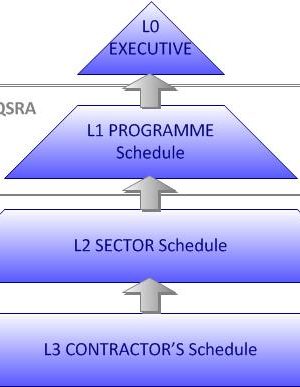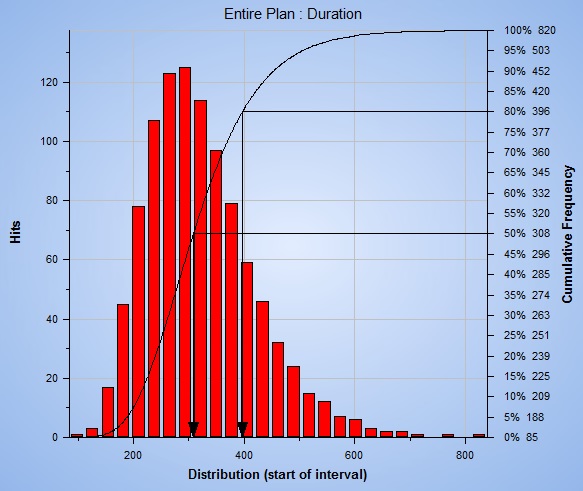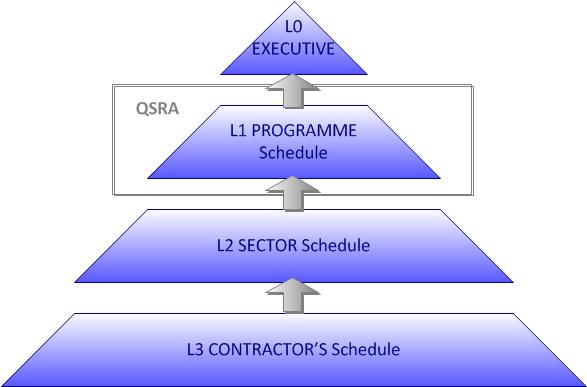
Managing Schedule Risk
Document
type: Micro-report
Author:
Nikki Underwood
Publication
Date: 13/03/2018
-
Abstract
This document briefly sets out some key features of how schedule has been managed and undertaken by Crossrail. The main focus is on Crossrail’s approach to Quantified Schedule Risk Analysis (QSRA) which has a degree of originality, particularly in relation to schedule size and schedule features. This report would be of interest to any programme, project or risk professionals managers looking to develop their management of schedule risk.
-
Read the full document
Introduction and Industry Context
Quantitative Schedule Risk Analysis (QSRA) is a simple yet effective technique to connect the risk information of project activities to the baseline schedule, in order to provide sensitivity information of individual project activities to assess the potential impact of uncertainty on the final project duration and cost. The objective of a QSRA is to forecast the completion (or intermediate milestone) of the programme. Understanding of the key risks, opportunities & uncertainties driving the forecast are an integral part of this activity
All but the simplest projects make use of a project schedule. A schedule is a list of a project’s milestones, activities, and deliverables, with intended start and finish dates. Both clients and contractors are usually extremely keen to see their projects delivered to time and hence managing schedule risk on major projects is vital.
It is common on major projects to carry out QSRA’s to assess the potential for on-time delivery, to understand the relative importance of different risks and to assess the benefits of different mitigations. See example below showing “S” curve for results and “Tornado Graph” of key risk drivers. For both graphs the longer the bar the greater effect the risk has on the completion date:Figure 1 – “S” Curve showing 50th and 80th percentile
Figure 2 – Tornado Graph showing key risk drivers
This document briefly sets out some key features of how schedule has been managed by project managers. The main focus of this report is on Crossrail’s approach to QSRAs which has a degree of novelty, particularly in relation to schedule size and schedule features such as calendars. Hence aspects of QSRAs that are common between Crossrail and other organisations are not covered.
Key Elements of Crossrail’s Approach to QSRA
a) Managing and Reporting Schedule Risk
Managing schedule risk is the responsibility of project managers. In the earlier years of the project this was reasonably straightforward as the interfaces between the projects were limited. Hence in those early years delivery to time was generally down to the individual contract/area to resolve. In the later years of the project interfaces became more important. This frequently meant that mitigations required several contractors to modify their resources and/or plans as a result.
The Crossrail schedules are detailed in the Planning and Scheduling Handbook (section 2.1).The schedules used by project managers are defined as Level 2 and Level 3. These are contract specific. Hence for key interfaces, as on many projects, simple spreadsheets have been used for tracking e.g. a spreadsheet is used for room handovers from Station contractors to Systemwide contractors.
The interfaces between contracts are set out in the Level 1 schedule. This includes Anchor Milestones – which are reported widely. Every four weeks a schedule review is carried out with Senior Directors, (and as of 2017 with the contractors’ Directors too), to understand key schedule issues, especially around interfaces. These meetings are frequently the forum for decisions on schedule risk mitigations.b) Possession QSRAs
Crossrail undertakes possession QSRAs for works that could affect the National Rail network. These are undertaken on minute by minute engineering schedules in a similar manner to other organisations.
c) Semi Annual Construction Report (SACR)
Crossrail produces, for its Sponsors, a report every six months setting out its progress and key deliverables for the next six months. It also includes a summary of a QSRA report, including the percentage likelihood of achieving stage opening milestones to time. The QSRA is not only important in its own right, but the linkage between schedule and cost means the conclusions of the QSRA report have a budgetary bearing too.
The QSRA is produced as per best practice on other major projects. In particular there is a focus on collaborative working with planners and project managers. Every effort is made to articulate potential divergences from the plan as risk rather than uncertainty. This is because risks potentially can be mitigated, whereas uncertainty cannot. Senior Executives take a close interest in it, review the findings and instigate fresh mitigations as a result.Challenges of Quantitative Schedule Risk Analysis
The nature of the Crossrail project means there are several challenges with respect to QSRAs which are covered in detail below.
The QSRA uses the level 1 schedule. This is the only Primavera P6 schedule that shows logic (i.e. dependencies) between projects. Since the completion of tunnelling the Level 1 schedule typically has 4,000 to 5,000 current and not yet commenced basic activities (this excludes milestones and summary bar activities).The complexity of interfaces drives this number. There are interfaces between each Systemwide contract (such as track, signalling, telecoms) and each station. In addition there are interfaces between the testing programme for the new fleet of trains (and the training of their drivers) and the commissioning and regulatory approvals for the new railway. This schedule is larger than for most other major project QSRAs, which typically have 200 to 1,000 activity schedules. The different levels of schedules used in CRL are illustrated below:Figure 3 – Levels of schedules used in CRL
The effect of the schedule size is:
- The risk personnel managing the QSRA need significant planning skills.
- As schedule risks need to be articulated at a low level the QSRA benefits from being produced by a team. This in turn means thorough version control is needed.
It is recommended that other projects at an early stage review their schedule hierarchy and structure construction with respect both to planning and QSRA needs. In particular, the use of a smaller schedule (a Level 0) would reduce the time required to carry out a QSRA and hence facilitate more frequent analysis e.g. monthly reports.
For most QSRAs a planner provides a planning file to the risk expert. For a schedule as large as Crossrail this results in an extremely large file which can be slow to load. To avoid this at Crossrail the direct link from Primavera P6 to the risk analysis software has been used. This enables the number of activity codes imported to be reduced, which in turn reduces the file size.
The overall scale and complexity of the end-to-end schedule means that every aspect of the QSRA takes longer to produce. In addition there are two particular aspects of the schedule which have been highlighted:- The schedule includes operational activities – particularly for movement of trains and testing with trains. These usually have a 2 shift/day calendar. When these activities are imported the risk analysis software recognises these activity durations as being double length in terms of days.
- The schedule includes works information produced by Network Rail. Network Rail and Crossrail have different “data dates” for the schedules. This means the Network Rail activities can appear in the risk analysis tool to be 14 days early.
There is a facility in the risk analysis tool to address this “data date” issue but its use doesn’t guarantee success. As a result of these two issues significant manual alteration to the schedule within the risk software has been required simply to line up dates between the planning and risk tools. Hence for other projects it is recommended that if a schedule needs to be used for risk analysis then ideally the aspects described above need to be avoided or if they are necessary then that there is sufficient planning skills applied to the process of bringing the schedule into the risk tool.
Conclusion and Lessons Learnt
Crossrail has carried out a number of QSRAs. These have been done using best industry practice.
The lessons learnt are:- QSRAs require collaborative working with both planners and project managers
- Buy in from Senior Executives is important, through reviewing the findings they can assist with identifying and agreeing mitigations
- Education of the recipients is essential. The recipients of the QSRA must understand what the result means, what assumptions have been made in preparing the analysis and what mitigations are required or are already being taken to make the ‘post-mitigation’ result a realistic outcome
- Articulating potential divergence from schedule by risks rather than uncertainty means the potential to mitigate is improved
- Choice of schedule is vital. Crossrail has a number of schedules for individual projects. These project schedules do not include linkages to other Crossrail projects. Hence using them for a QSRA would provide results for individual projects but not for the whole programme. In addition to these project schedules Crossrail has one programme schedule (known as Level 1 schedule) of 4,000 to 5,000 activities that shows inter-project linkages. Hence that was used, though there is a case on other projects with similar schedules to review the potential for an even higher level schedule in order to reduce the time taken to link risks and activities. A higher level schedule might be produced by keeping the detail in the higher risk areas of the project and summarising in other areas
-
Authors
Nikki Underwood - Crossrail Ltd
Nikki Underwood (nee Gash) has been Head Of Programme Risk since December 2016. During this period she has led the development and implementation of programme risk management; rebalancing the focus on schedule risk as well as cost risk, redefining the processes, rebuilding the systems and aligning the strategy and governance to the delivery requirements during the final phase of the project.
Prior to joining Crossrail, Nikki worked in various risk management roles both in the UK and internationally. She has worked on major projects such as West Coat Route Modernisation and Sharq Crossing in Doha. Nikki has 15 years experience of both risk management and project management on both contractor and client side working for organisations such as London Underground and Network Rail.



